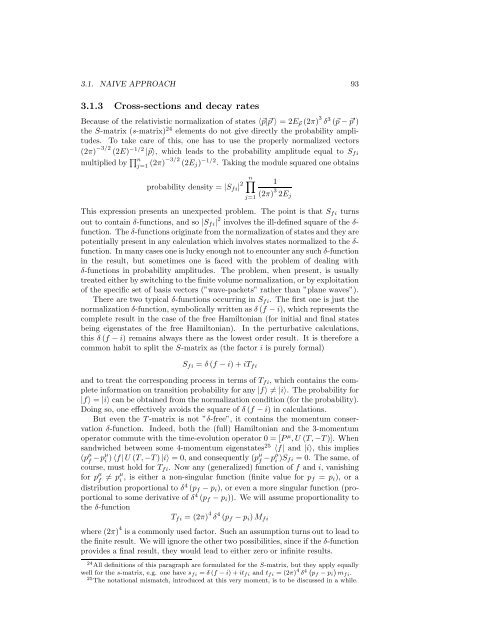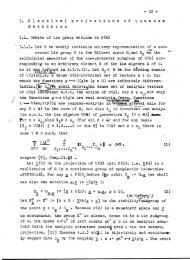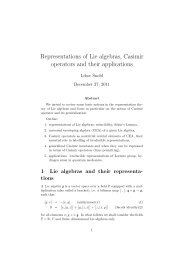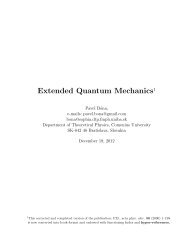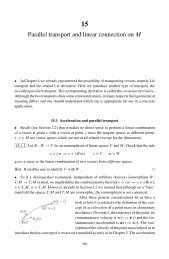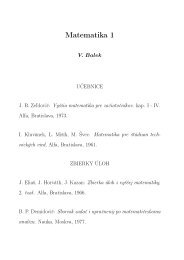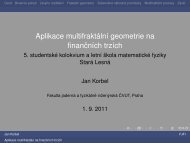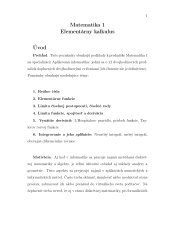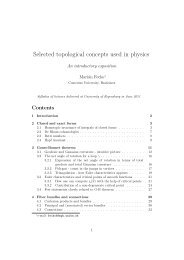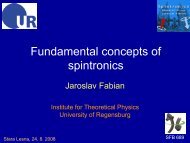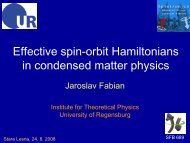Quantum Field Theory I
Quantum Field Theory I
Quantum Field Theory I
Create successful ePaper yourself
Turn your PDF publications into a flip-book with our unique Google optimized e-Paper software.
3.1. NAIVE APPROACH 93<br />
3.1.3 Cross-sections and decay rates<br />
Because of the relativistic normalization of states 〈⃗p|⃗p ′ 〉 = 2E ⃗p (2π) 3 δ 3 (⃗p−⃗p ′ )<br />
the S-matrix (s-matrix) 24 elements do not give directly the probability amplitudes.<br />
To take care of this, one has to use the properly normalized vectors<br />
(2π) −3/2 (2E) −1/2 |⃗p〉, which leads to the probability amplitude equal to S fi<br />
multiplied by ∏ n<br />
j=1 (2π)−3/2 (2E j ) −1/2 . Taking the module squared one obtains<br />
probability density = |S fi | 2 n<br />
∏<br />
j=1<br />
1<br />
(2π) 3 2E j<br />
This expression presents an unexpected problem. The point is that S fi turns<br />
out to contain δ-functions, and so |S fi | 2 involves the ill-defined square of the δ-<br />
function. Theδ-functionsoriginatefromthenormalizationofstatesandtheyare<br />
potentially present in any calculation which involves states normalized to the δ-<br />
function. Inmanycasesoneisluckyenoughnottoencounteranysuchδ-function<br />
in the result, but sometimes one is faced with the problem of dealing with<br />
δ-functions in probability amplitudes. The problem, when present, is usually<br />
treatedeitherbyswitchingtothe finitevolumenormalization,orbyexploitation<br />
of the specific set of basis vectors (”wave-packets” rather than ”plane waves”).<br />
There are two typical δ-functions occurring in S fi . The first one is just the<br />
normalization δ-function, symbolically written as δ(f −i), which represents the<br />
complete result in the case of the free Hamiltonian (for initial and final states<br />
being eigenstates of the free Hamiltonian). In the perturbative calculations,<br />
this δ(f −i) remains always there as the lowest order result. It is therefore a<br />
common habit to split the S-matrix as (the factor i is purely formal)<br />
S fi = δ(f −i)+iT fi<br />
and to treat the corresponding process in terms of T fi , which contains the complete<br />
information on transition probability for any |f〉 ≠ |i〉. The probability for<br />
|f〉 = |i〉 can be obtained from the normalization condition (for the probability).<br />
Doing so, one effectively avoids the square of δ(f −i) in calculations.<br />
But even the T-matrix is not ”δ-free”, it contains the momentum conservation<br />
δ-function. Indeed, both the (full) Hamiltonian and the 3-momentum<br />
operator commute with the time-evolution operator 0 = [P µ ,U (T,−T)]. When<br />
sandwiched between some 4-momentum eigenstates 25 〈f| and |i〉, this implies<br />
(p µ f −pµ i )〈f|U (T,−T)|i〉 = 0, and consequently (pµ f −pµ i )S fi = 0. The same, of<br />
course, must hold for T fi . Now any (generalized) function of f and i, vanishing<br />
for p µ f ≠ pµ i , is either a non-singular function (finite value for p f = p i ), or a<br />
distribution proportional to δ 4 (p f −p i ), or even a more singular function (proportional<br />
to some derivative of δ 4 (p f −p i )). We will assume proportionality to<br />
the δ-function<br />
T fi = (2π) 4 δ 4 (p f −p i )M fi<br />
where (2π) 4 is a commonly used factor. Such an assumption turns out to lead to<br />
the finite result. We will ignorethe othertwo possibilities, since if the δ-function<br />
provides a final result, they would lead to either zero or infinite results.<br />
24 All definitions of this paragraph are formulated for the S-matrix, but they apply equally<br />
well for the s-matrix, e.g. one have s fi = δ(f −i)+it fi and t fi = (2π) 4 δ 4 ( p f −p i<br />
) mfi .<br />
25 The notational mismatch, introduced at this very moment, is to be discussed in a while.


